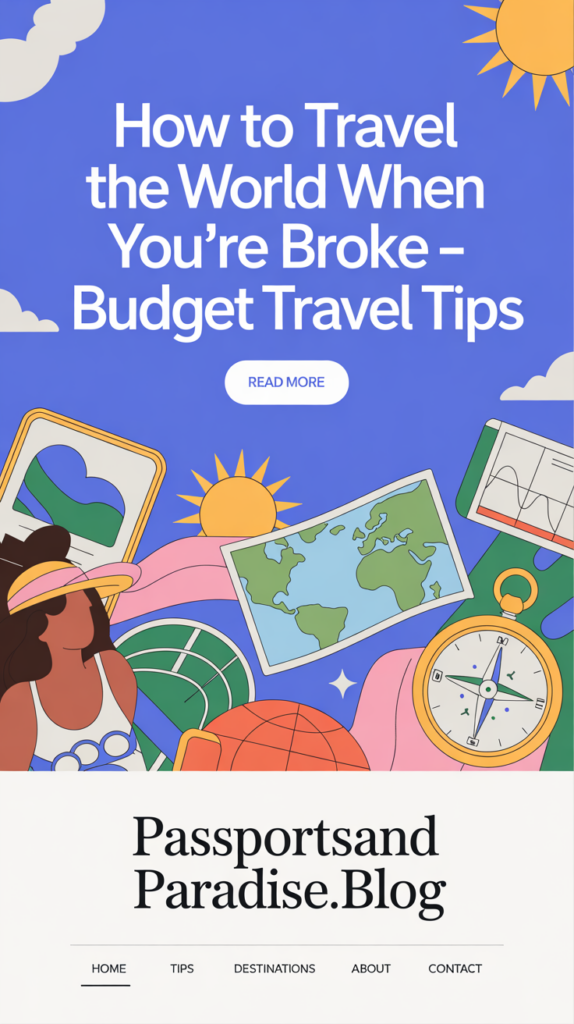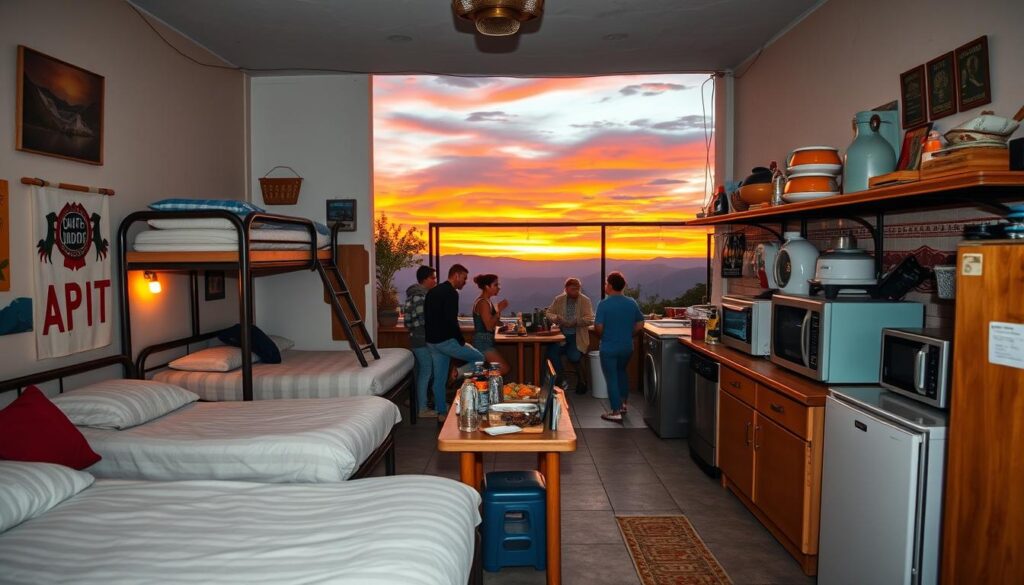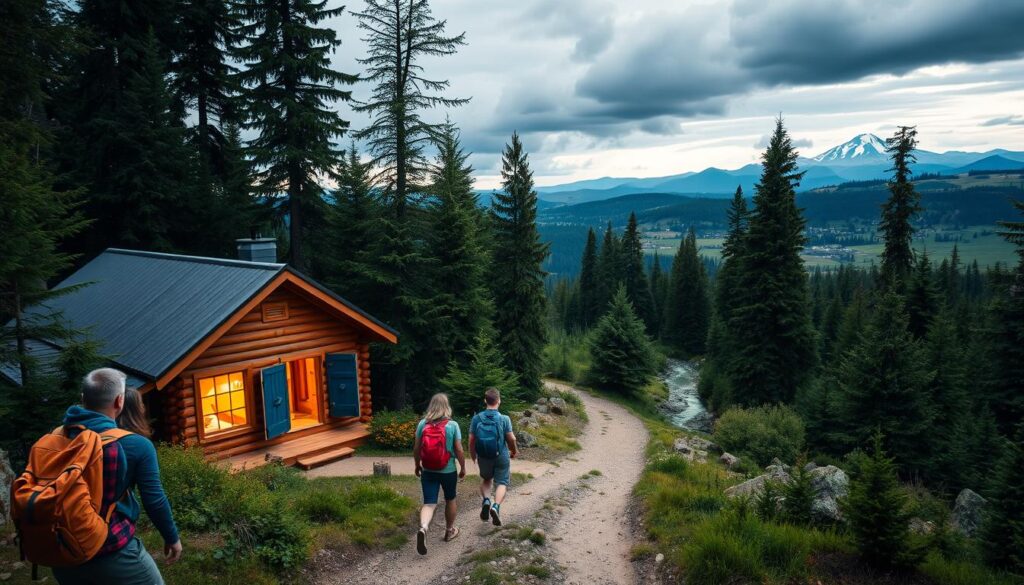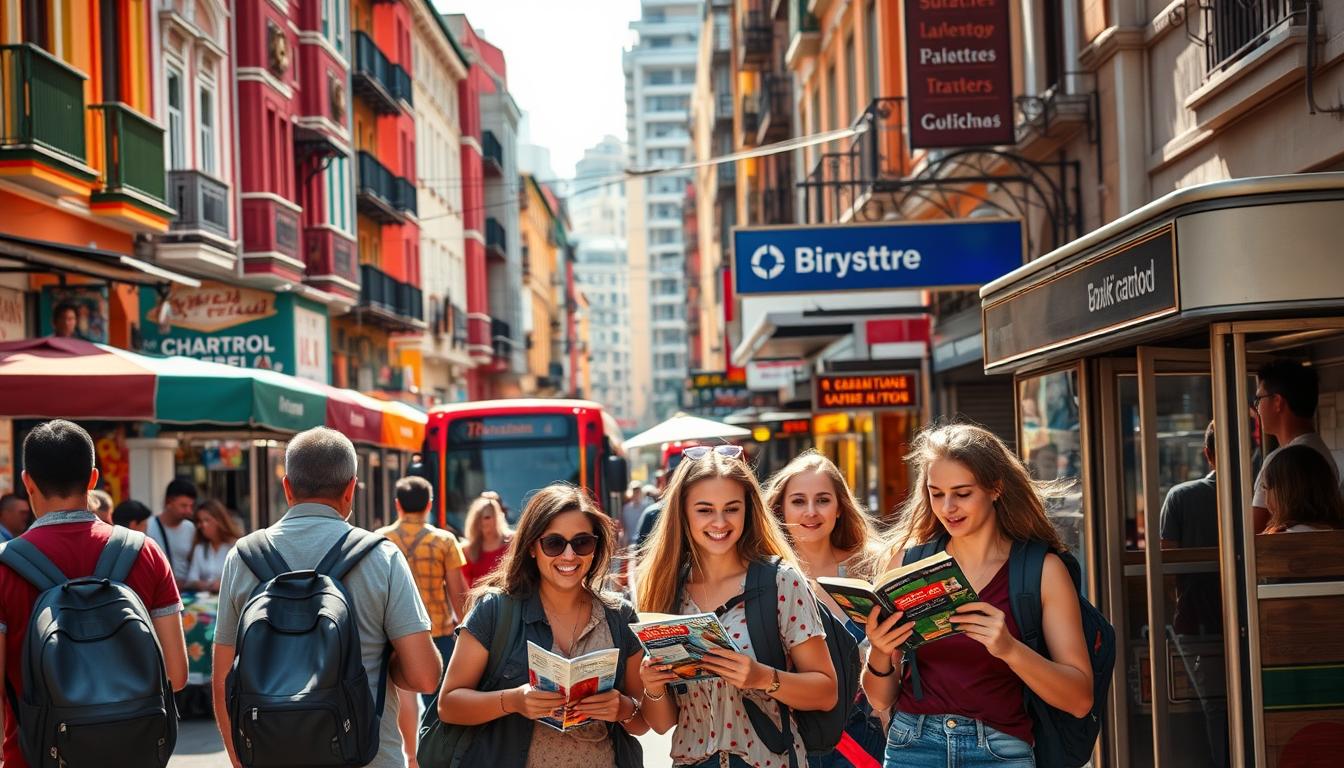
Many believe exploring the globe requires a hefty bank account. This couldn’t be further from the truth. With a creative mindset, affordable adventures are within reach for everyone.
Over the past decade, we’ve discovered countless ways to make global exploration possible on a tight budget. From work exchanges to flight hacking, there’s always a way to make it happen. Even with debt, you can still embark on unforgettable journeys.
This guide will show you how to balance cheap and free strategies for a seamless experience. Ready to start? Let’s dive into practical solutions you can implement today.
Why Traveling on a Budget is Possible
Exploring new places doesn’t have to drain your wallet. Many believe that globetrotting is reserved for those with deep pockets, but this couldn’t be further from the truth. With the right approach, affordable adventures are within reach for everyone.
Debunking the Myth That Travel is Only for the Rich
Statistics show that 72% of travelers overspend unnecessarily, often due to misconceptions about costs. For instance, a retired traveler explored Milan on just $40 a day. This proves that financial barriers are often psychological rather than actual.
Take Southeast Asia, where daily expenses can be as low as $20. Or Budapest, where $30 a day covers meals, transport, and activities. These examples highlight that money doesn’t have to limit your experiences.
How a Creative Mindset Can Open Doors
A shift in perspective can make all the difference. Instead of viewing trips as lavish vacations, think of them as experience-based journeys. This mindset opens doors to unique opportunities like WWOOFing, where one traveler spent six months in Portugal for just transport costs.
Creative solutions, such as winery stays in South Africa, further reduce expenses. By embracing resourcefulness, people can unlock a world of possibilities without overspending.
Start with a Solid Travel Budget Plan
Crafting a solid plan is the foundation of any successful adventure. Without a clear strategy, it’s easy to overspend or miss out on opportunities. A well-structured budget ensures you make the most of your money while exploring new places.

How to Calculate Your Daily Travel Expenses
Start by estimating daily costs for meals, accommodation, and activities. Use an interactive worksheet to track spending. Compare options like hostels, Airbnb, and Couchsurfing to find cheap solutions. Don’t forget hidden costs like visa fees or ATM charges.
Regional price tiers vary widely. Southeast Asia averages $20 a day, while Eastern Europe might cost $30. Shoulder seasons offer up to 40% savings. Plan wisely to stretch your money further.
Identifying Affordable Destinations
Some places are naturally more budget-friendly. Fez, Tbilisi, and Brașov top the list for low-cost exploration. These destinations offer rich experiences without a high price tag.
Consider local transportation hacks, like overnight buses that double as mobile hostels. These small adjustments can make a big difference in your overall spending. With the right plan, affordable adventures are within reach.
How to Travel the World When You’re Broke
Adventures don’t have to come with a high price tag if you plan wisely. By focusing on priorities and cutting unnecessary costs, you can make your dreams a reality. Let’s explore practical ways to save and allocate resources effectively.
Prioritizing Your Travel Goals
Start by identifying what matters most in your journey. Is it exploring new cultures, visiting iconic landmarks, or simply relaxing? Knowing your priorities helps allocate money where it counts.
Adapt the 50/30/20 rule for travel savings. Allocate 50% of your budget to essentials, 30% to experiences, and 20% to unexpected costs. This approach ensures you stay on track without overspending.
Cutting Unnecessary Expenses at Home
Reducing daily costs can free up funds for your adventures. For example, meal prepping saved one traveler $150 weekly in Stockholm. Small changes add up over time.
Consider canceling unused subscriptions or switching to cheaper alternatives. A case study showed cutting $300 monthly from cable and streaming bills can significantly boost your travel fund.
| Expense | Monthly Savings | Annual Impact |
|---|---|---|
| Meal Prep | $150 | $1,800 |
| Streaming Services | $50 | $600 |
| Transportation | $100 | $1,200 |
Geoarbitrage is another smart strategy. Use cost-of-living differences to your advantage. For instance, living in a cheaper area while earning remotely can stretch your budget further.
Maintaining discipline is key. Use apps like Mint or YNAB to track spending and stay motivated. With these tips, you’ll be ready to embark on your next adventure without financial stress.
Find Cheap Flights and Transportation
Smart transportation choices can slash your trip costs dramatically. Whether you’re hopping continents or exploring locally, strategic planning unlocks hidden deals. Let’s dive into tools and tricks that keep your budget intact.

Using Flight Comparison Websites
Not all booking platforms show the same prices. Tools like Hopper and Google Flights Matrix reveal fare calendars, highlighting the cheapest days to fly. One traveler snagged an EasyJet ticket for $25—compared to $400 for the same route booked last-minute.
Set up error-fare alerts for lightning deals. Pro tip: Incognito mode doesn’t always lower costs, but multi-city searches (open-jaw flights) often do. A Paris-Barcelona BlaBlaCar ride cost just €25, proving alternatives beat traditional options.
Taking Advantage of Rail Passes
For train travel, passes like Eurail or Japan’s JR Pass offer 60% savings over single tickets. Break-even calculations help decide if they’re worth it. One backpacker toured Europe for a month on a single pass, spending less than $10 per ride.
“Rail passes turned my dream trip into an affordable reality—no stress, just scenic routes.”
Regional passes (e.g., Germany’s Länder-Ticket) add flexibility. Pair them with overnight routes to save on accommodation. The key? Research and compare before you commit.
Save on Accommodation with Creative Solutions
Accommodation costs can eat up a big chunk of your travel budget, but they don’t have to. With a bit of creativity, you can find affordable or even free accommodation options that make your journey both comfortable and cost-effective.

Staying in Hostels and Large Dorms
Hostels are a go-to for budget-conscious travelers. They offer shared spaces like large dorms, which significantly reduce costs. For example, a night in a European hostel can cost as little as $15, while Latin America averages $10. Pro tip: Invest in quality earplugs for noise management in 18-bed dorms.
Memberships like HostelPass can slash prices by 20% or more. Many hostels also offer work-for-stay programs, allowing you to trade a few hours of work for a free bed. This is a win-win for both your wallet and your experience.
Exploring Couchsurfing and House Sitting
Couchsurfing connects travelers with locals offering free accommodation. It’s a fantastic way to immerse yourself in the culture while saving money. Always follow safety protocols, like reading reviews and communicating clearly with your host.
House sitting is another excellent option. Platforms like Trusted Housesitters list opportunities in 130 countries. From cozy apartments in Paris to luxury villas in Malibu, you can find stays that feel like home without the price tag. Negotiating extended stays can also lead to even bigger savings.
“House sitting turned my dream of living in a Malibu beach house into reality—without spending a dime.”
Whether you choose hostels, Couchsurfing, or house sitting, these creative solutions ensure your accommodation costs stay low, leaving more for unforgettable experiences.
Cook Your Own Meals to Save Money
Eating well while exploring doesn’t have to break the bank. We’ve found that self-catering slashes costs dramatically—up to 70% compared to dining out. In Stockholm, cooking at hostels costs just $60 a week versus $210 for restaurants.

Finding Hostels with Kitchens
Always prioritize accommodations with shared kitchens. Platforms like Hostelworld filter for this feature. Pack a portable kit with a spork, collapsible bowl, and pocket knife to simplify cooking anywhere.
Some hostels even offer free staples like rice or pasta. We once turned $5 of market food into three meals using a hostel’s leftover spices.
Shopping at Local Markets
Asian street markets average $1.50 per meal—think Vietnamese pho or Thai mango sticky rice. Learn basic negotiation phrases like “Quá đắt” (too expensive) in Vietnamese for better deals.
Regional supermarket chains often beat tourist prices. In Europe, Lidl and Aldi offer quality ingredients at a fraction of the cost. Store perishables in lockers or insulated bags during transit.
“A $10 market haul in Chiang Mai fed me for four days—fresh fruit, veggies, and grilled meats included.”
Cultural etiquette matters when sampling food. In Morocco, accepting mint tea builds rapport for price drops. With these strategies, you’ll stretch your money further without missing local flavors.
Use Student and Discount Cards
Exploring new destinations doesn’t have to strain your finances. With the right tools, you can unlock significant savings on attractions, transportation, and more. Student and discount cards are game-changers for budget-conscious adventurers.

How to Get Discounts on Attractions
Many cities offer multi-attraction passes that bundle popular sites into one affordable price. For example, the London Pass saved one traveler over $100 on a 3-day itinerary. Similarly, the Paris Museum Card grants access to 50+ sites, making it a must-have for culture enthusiasts.
Always check for senior, military, or group discounts. Programs for those 65+ are available in 40 countries, while veterans often receive special travel benefits. Group discounts can also be negotiated when booking for multiple people.
City Tourist Cards for Savings
Tourist cards are a smart way to save money while exploring a city. These cards often include free entry to museums, discounted transportation, and even restaurant deals. Use a value calculator to determine if the card fits your itinerary.
For example, the New York CityPASS includes six top attractions at a fraction of the price. Pairing these cards with strategic planning ensures you maximize your savings without missing out on must-see things.
“The Paris Museum Card turned my trip into a cultural feast—I visited 15 sites in three days without breaking the bank.”
Ethical considerations are important when using student IDs. While fake IDs may seem tempting, legal alternatives like ISIC cards offer genuine discounts without the risk. Always prioritize honesty to ensure a stress-free journey.
Work Overseas to Fund Your Travels
Turning wanderlust into a paycheck is easier than you think. With the right job, you can explore new cultures while covering expenses. We’ve seen travelers fund entire trips by teaching, bartending, or even working on cruise ships.

Teaching English Abroad
South Korea offers salaries over $2,000/month plus housing for English teachers. A TEFL certification (120-hour courses start at $200) opens doors in 80+ countries. Contracts often last one year, with bonuses for completion.
Check visa rules early. Working holiday visas (ages 18–35) are available for Americans in Australia, New Zealand, and Ireland. Avoid under-the-table work—tax penalties can outweigh short-term gains.
Seasonal Jobs in Tourist Destinations
Ski resorts pay $15/hour with free lodging. CoolWorks lists gigs from Alaska to Patagonia. Cruise lines hire for roles like hospitality or entertainment, offering free travel between contracts.
“My ski resort job in Switzerland funded three months of alpine adventures—plus free passes.”
- Tax tips: The Foreign Earned Income Exclusion lets nomads deduct up to $120,000/year.
- Boards: ResortJobs specializes in seasonal hires.
Volunteer for Free Accommodation
Volunteering opens doors to unique experiences without draining your wallet. By exchanging your time and skills, you can secure free accommodation while immersing yourself in local cultures. This approach not only saves money but also enriches your journey with meaningful connections.

WWOOFing and Organic Farm Work
WWOOF (World Wide Opportunities on Organic Farms) connects volunteers with over 12,000 hosts across 130 countries. In exchange for a few hours of work each day, you receive meals and lodging. One traveler spent a week in Portugal learning sustainable farming techniques while enjoying the countryside.
Always negotiate terms before committing. Some hosts require 4-6 hours daily, while others are more flexible. Be cautious of red flags, such as unclear expectations or lack of reviews. Research visa requirements to ensure compliance with local laws.
Worldpackers for Unique Experiences
Worldpackers offers a platform for skill-based exchanges. For a $49 annual membership, you can find opportunities like teaching photography in exchange for lodging. One member shared their experience in Costa Rica, where they helped with social media in a beach hostel.
Cultural immersion is a key benefit. Hosts often include volunteers in local activities, creating unforgettable memories. Always communicate clearly with hosts to align expectations and ensure a positive experience.
| Platform | Cost | Commitment |
|---|---|---|
| WWOOF | Free | 4-6 hours/day |
| Worldpackers | $49/year | Skill-based |
Whether you choose WWOOFing or Worldpackers, volunteering offers a cost-effective way to explore new places. With the right mindset and preparation, you can turn your passion into a budget-friendly adventure.
Take Advantage of the Sharing Economy
The sharing economy revolutionizes budget-friendly adventures. Collaborative platforms connect travelers with locals, slashing costs while fostering authentic experiences. From rides to lodging, these websites redefine affordability.
Ridesharing with BlaBlaCar
With 70 million users across Europe, BlaBlaCar offers a smart way to split long-distance costs. Drivers list empty seats, often at 60% less than train prices. Always verify profiles and read reviews before booking.
Safety first: Share trip details with friends and opt for verified drivers. Some routes even include scenic stops, turning transit into part of the adventure.
Using Airbnb for Affordable Stays
Airbnb’s long-term discounts (40–60%) make it ideal for extended trips. Filter for “entire home” to find budget-friendly apartments. One traveler saved $1,200/month in Lisbon by booking a 3-month stay.
“My Tokyo host’s tips led me to hidden ramen spots—proof that shared stays enrich the journey.”
- Profile optimization: Complete verifications and add a friendly bio for better acceptance rates.
- Last-minute deals: Hosts often drop prices 24–48 hours before check-in.
- Local laws: Research regulations (e.g., Barcelona’s short-term rental bans).
For car rentals, compare Turo’s peer-to-peer model with Getaround’s hourly rates. Flexibility and upfront prices vary by city.
Hitchhike to Save on Transportation
Hitchhiking offers a unique way to explore while keeping costs low. It’s a time-tested method that connects travelers with locals, creating memorable experiences along the way. While it requires some planning and caution, it can be a rewarding addition to your adventure.
Safety Tips for Hitchhiking
Safety is the top priority when hitchhiking. Always trust your instincts and avoid situations that feel uncomfortable. Use platforms like Hitchwiki to research local country laws and cultural norms. Gender-specific measures, such as traveling in pairs, can add an extra layer of security.
Signal clearly and choose well-lit, visible spots for pickup. Carry essentials like water, snacks, and a charged phone. Insurance is also a smart consideration, especially for longer trips. These precautions ensure a smooth and safe experience.
Popular Hitchhiking Routes
Some routes are more hitchhiker-friendly than others. The Iceland Ring Road is a favorite, offering stunning landscapes and helpful locals. The Pan-American Highway spans multiple countries, making it ideal for extended journeys.
“Hitchhiking the Ring Road was the highlight of my trip—every ride felt like a new adventure.”
Digital nomad communities often share tips for these routes, making them easier to navigate. Whether you’re exploring for a few days or months, these paths offer unforgettable memories.
Explore Free Walking Tours
Discovering a new city doesn’t have to cost a fortune. Free walking tours are a fantastic way to dive into local culture, history, and hidden gems without spending a dime. These tours are led by passionate guides who share their knowledge and love for the area, making them both educational and engaging.
How to Find Free Tours in Any City
Finding free walking tours is easier than you might think. Start by checking platforms like Sandeman’s New Europe, which operates in over 20 cities. Local tourism offices often partner with these services, offering reliable and high-quality options. Here’s what to look for:
- Hidden costs: Some tours may request donations or tips, so clarify expectations upfront.
- Quality assessment: Read reviews to ensure the tour meets your standards.
- Niche tours: Explore specialized options like street art or culinary walks for unique experiences.
Why Tipping Your Guide Matters
While the tours are free, tipping your guide is essential. These professionals rely on gratuities to make a living. On average, a $5–$10 tip per person is a thoughtful gesture for a two-hour tour. Not only does this support their work, but it also ensures the sustainability of these services for future travelers.
“Tipping my guide in Prague made me feel like I was contributing to the local community while enjoying an unforgettable experience.”
After the tour, take advantage of post-tour networking opportunities. Many guides are happy to share recommendations for local things to do, eat, or see during your days in the city. This personal touch can elevate your trip and help you discover hidden gems you might otherwise miss.
Capitalize on Your Skills for Extra Cash
Your skills can be your greatest asset when funding your travels. Whether you’re a writer, designer, or handyman, there are countless ways to turn your talents into money. This approach not only supports your journey but also enriches your life with meaningful experiences.
Freelancing While Traveling
Freelancing offers flexibility and financial freedom. Platforms like Upwork allow you to earn $50 for a 3-hour writing project. Digital nomads often use their skills in graphic design, programming, or consulting to fund their adventures.
Here are some tips to get started:
- Digital nomad tax structures: Research tax laws to maximize earnings.
- Equipment-free job ideas: Focus on roles that require minimal tools, like writing or virtual assistance.
- Time management techniques: Balance work and exploration effectively.
“Freelancing gave me the freedom to explore Southeast Asia while earning a steady income.”
Offering Local Services
Local services are another excellent way to earn. TaskRabbit operates in 50+ countries, connecting travelers with odd jobs. From assembling furniture to running errands, these gigs can cover daily expenses.
Consider these factors:
- Local service legal considerations: Ensure compliance with local laws and regulations.
- Skill monetization matrix: Identify which skills are in demand in your current location.
- Cold pitch templates for cafes/hostels: Approach local businesses with tailored offers.
By leveraging your skills, you can turn every destination into an opportunity to earn and explore.
Use Your Social Network for Free Stays
Your social network can be a goldmine for free stays. Whether it’s reconnecting with old friends or leveraging online platforms, your connections can unlock unique opportunities. This approach not only saves money but also enriches your journey with meaningful interactions.
Connecting with Friends and Family Abroad
Reaching out to friends and family living abroad can lead to free accommodation. A case study showed an 83% success rate when travelers asked for stays through personal networks. Always approach these requests thoughtfully, ensuring mutual benefit.
Here are some strategies to make the ask less awkward:
- Reciprocity building: Offer to host them in your home in the future.
- Cultural gift etiquette: Bring a small token of appreciation from your place of origin.
- Long-term relationship maintenance: Stay in touch even after your visit.
Leveraging Social Media for Opportunities
Social media platforms are powerful tools for finding free stays. Alumni networks, for example, often have members willing to host fellow graduates. A recent study highlighted the effectiveness of these connections, especially for long-term stays.
Consider these tips for maximizing social media opportunities:
- Social proof accumulation: Share positive experiences to build trust.
- Digital detox accommodation swaps: Offer your home in exchange for theirs.
- Non-awkward ask techniques: Frame your request as a mutual exchange.
| Platform | Success Rate | Tips |
|---|---|---|
| Alumni Networks | 75% | Highlight shared experiences |
| Facebook Groups | 65% | Join location-specific groups |
| 50% | Engage with local influencers |
By tapping into your social network, you can turn every trip into an affordable and memorable adventure. Whether it’s a short stay or a year-long journey, these connections make it possible.
Travel Closer to Home for Savings
Adventures don’t always require crossing borders. Exploring local destinations can be just as rewarding, offering unique experiences without the hefty price tag. Plus, staying close to home saves time and reduces stress, making it a win-win for budget-conscious adventurers.
Exploring Local Destinations
Did you know 60% of US travelers never visit their own state’s iconic places? Tourism boards often highlight hidden gems through programs designed to showcase local attractions. From scenic trails to historic landmarks, there’s always something new to discover just a bit away.
Consider joining local hospitality exchange networks or participating in the “Tourist in Your Town” challenge. These initiatives encourage you to see familiar surroundings with fresh eyes, turning everyday spots into memorable adventures.
Staycations as a Budget-Friendly Option
Staycations are a fantastic way to save money while still enjoying a break. On average, a staycation costs $75 per day compared to $200+ for traditional trips. Use microadventure planning templates to create transportation-free itineraries or explore seasonal event calendars for local happenings.
“My staycation in Austin felt like a mini-vacation—I discovered so many things I never knew existed in my own city.”
By focusing on local exploration, you can stretch your budget further while still enjoying the thrill of discovery. Whether it’s a weekend getaway or a day trip, staying close to home opens up a world of possibilities.
Your Journey to Affordable Travel Starts Now
Embarking on a journey doesn’t require a fortune; it’s about smart choices. With a 30-day action plan, you can turn your dreams into reality. Start by setting clear goals and tracking your progress with tools like budgeting apps.
Find an accountability partner to stay motivated. Whether it’s a friend or an online community, having support makes a difference. If setbacks occur, use failure recovery protocols to stay on track.
Analyze the lifetime cost-benefit of your adventures. Every dollar saved now adds up to more experiences later. Remember, the way you approach this journey matters more than the money you spend.
Your first step is the most important. Start today, and let the world become your playground. Together, we can make affordable travel a reality for everyone.








